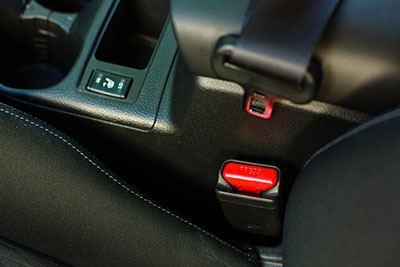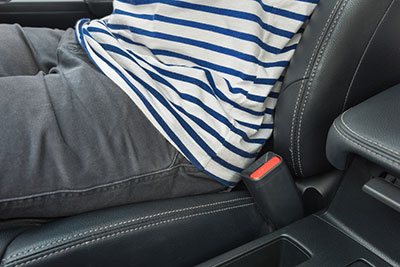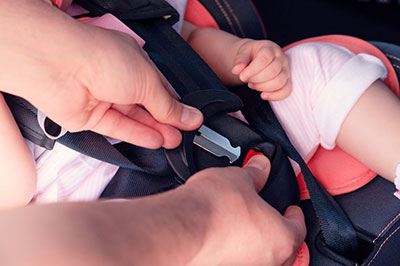Installing the child's car seat for the first time can be challenging for many parents.
Deciding to install the car seat with a seat belt vs LATCH is never easy, especially with the advantages and disadvantages of both installation methods.
If you want to learn the difference between these two installations, we offer a complete comparison of both pros and cons of the seat belt and LATCH system.
Then, find out which method is safer for your child and your vehicle's car seat.
More...
What is ISOFIX?
ISOFIX and LATCH refer to the same anchoring system but have different regional names.
ISOFIX is a term used in Europe for lower latch anchors, while the term LATCH is primarily used in the American market.
The name 'ISOFIX' comes from the International Organization for Standardization standard ISO 13216 and stands for:
- Vehicles manufactured in Europe.
- The corresponding anchors on the child restraint seats match the European safety standard.
The ISOFIX system attaches the car seat base to the metal anchor points of the vehicle seat. Most vehicles will allow for direct installation, while other car seats require a car seat base for a secure fit.
Once the car seat is attached to the lower anchor, the next step is stabilizing the support leg of the safety seats to reach the floor.
Some ISOFIX infant car seats include a top tether anchor which attaches behind the rear seat. The practicality of the ISOFIX system will allow you to use it with Group 0 (infant car seats) up to Group 3 (forward-facing seats).

What is LATCH?
The LATCH (Lower Anchors and Tethers for Children) is a car seat installation system that uses lower anchors of the vehicle to attach to the base of the car seat and the top tether.
Since September 1st, 2002, the LATCH system has been a safety requirement for all US car seats. The lower anchors are located in the rear seat, between the outer corner of each seat. However, since not every vehicle includes lower anchors, it's necessary to use the seat belt installation instead.
A LATCH system requires a top tether use. The top tether must always be used when installing a forward-facing car seat. The top tether limits the child's head movement during a crash and stabilizes the body in the car seat.
- Reduced risk of the seat being installed incorrectly.
- Easier to install in all car seats with lower anchors
- The LATCH system is a universal installation method
- The LATCH system has a weight limit
- Older vehicles usually lack a lower anchor
Using LATCH for car seat installation
When installing a car seat with a LATCH system, locate the lower anchors of the vehicle seat first. Next, connect the lower anchors of the vehicle seat to the anchors of the car seat base. Finally, pull the lever of the car seat to tighten the installation. The car seat should be as close to the vehicle seat as possible.
The top tether anchors offer added stability for the installation. Attach the top tether anchors on the back of the vehicle seat for a secure fit.
Once the car seat is installed, check for movement. The installed car seat with LATCH should not move more than one-inch front, back, or side to side, according to the general rule of installation.
You must consider the latch weight limit when installing the car seat. LATCH installations have a maximum weight limit of 65 pounds. However, it's best to consult the car seat manual first. Once the child exceeds the weight limit, the car seat has to be installed with a seat belt instead.
Tips for using a LATCH as an installation method
What is a Seat Belt Installation?

Seat belt installation requires a vehicle seat belt to be installed on the child's seat.
The most significant benefit of seat belt systems is compatibility! While not every car has lower latch anchors for the LATCH system, every vehicle has a seat belt! So if you travel abroad, switch cars, or often use public transport, seat belt installation is the easiest method!
Many vehicles do not have lower latch anchors in the middle seat, so if you want to install the car seat in the center seat, a seat belt is a way to go!
- Unlike latch systems, seat belts do not have a maximum weight limit for installation.
- Universal for every vehicle
- Seat belts can be used for center seat installation.
- Inflatable seat belts have not yet been tested with child seats.
- A few seat belt systems are not compatible with car seats.
- It can be challenging to get a tight fit.
Using seatbelt for car seat installation
Before installing the car seat with a vehicle seat belt, consult the car seat manual.
Start by placing the child's car seat in the vehicle's back seat, preferably in the center position. Next, thread the seat belt through the belt path guide.
The belt guides will be of different colors depending on whether you are installing the car seat in a rear-facing or forward-facing position, the belt guides will be of different colors. For example, the belt guides for the rear-facing position are blue, while the forward-facing car seat position has red guides.
Once the belt has passed through the guides, buckle it and lock the seat belt locks. Again, check the vehicle owner's manual, as every vehicle has different locking mechanisms.
After the seat is installed, ensure it does not move more than one inch from the vehicle seat.
Tips when using seat belt install method
Which is Safer: Seat Belt vs LATCH?
The seat belt and LATCH system are equally safe installation methods if used according to instructions. The LATCH has a few advantages regarding easier use, but it's not considered safer than the seat belt.
Using the seat belt does require more installation steps. However, the overall safety is just as guaranteed as with LATCH.
The LATCH system is preferably used for rear-facing seating positions due to its convenience. However, the LATCH method has a maximum weight limit you need to be careful about once transitioning to the forward-facing car seat.
Three out of four child car seats are installed incorrectly, with either a LATCH or a seat belt, according to NHTSA. The audible click in lower anchors and ISOFIX base assures parents of a well-performed installation, making them choose a LATCH as a safer method.
Whether you are using the seat belt or the LATCH system, keep in mind two safety guidelines:
- Child's weight: if the child's weight exceeds the lower anchor weight limit, it's best to switch to seat belt installation. Children up to 65 pounds can be supported with a LATCH install.
- Seating position: Most vehicles do not have lower or tether anchors, so it's best to opt for seat belt installation. If you install a car seat with the LATCH, ensure the lower anchors are correctly positioned and use the tether anchor for the forward-facing seating position.
Latch vs Seat Belt: When to Use Each Installation Method?
1. Three-across installations
Using the seat belt is smarter when installing multiple car seats in the back.
Although both the lower anchors and the seat belt are safe for car fittings, one has more advantages over the other. Lower anchors are usually located towards the center, while some vehicles do not feature center lower anchors at all!
Installing two seats with lower anchors and leaving one center seat for the seat belt install can cost you valuable space! Car seats installed with the LATCH systems take more space towards the middle due to the position of the lower anchors, with few exceptions. As a result, you are left with minimal space for the center seat.
Seat belts are perfectly acceptable for three across installations. With seat belts, you can easily install the car seat as close or spaced out towards the door.
Winner: Seat belt
2. Rear-faced & forward-faced tethering
Using the tether anchor is only possible with the LATCH system.
The top tether anchoring is commonly used with forward-facing installations for added security. The upper LATCH anchor is attached to the vehicle's back seat. By tethering the car seat, a child is less likely to have head trauma in case of a car crash. In addition, the tether limits the movement of the forward-facing car seat by offering a more secure position.
Rear-faced tethering is possible but not something parents put to practice.
Winner: LATCH system
3. Booster seat installation

Many parents wonder:
Is LATCH installation possible with booster seats?
Booster car seats do not need to be restrained to the vehicle's seat unless the child is buckled in with a seat belt. However, some belt-positioning boosters do come with latch connectors!
We talked about the weight limit on the LATCH, so how exactly can you use them with booster seats? LATCH in booster seats only prevents the booster from becoming a projectile in a crash.
The convenience of latches in boosters can also allow kids to climb to their seats a lot easier. However, it's best to read the vehicle owner's manual and check whether the LATCH installation is allowed with the booster. Some manufacturers will not allow latch booster installation due to the overlapping buckle.
Overall, you don't necessarily have to use the LATCH connectors on your booster. However, if you opt for the traditional booster installation method, store the connectors in the storage compartment.
Winner: Both
FAQs
Is it better to install a car seat with LATCH or a seat belt?
It's better to install a car seat with a seat belt due to the no-weight limit restrictions. Installing the LATCH system is only possible for up to 65 pounds of weight. After the child has exceeded the weight limit, a car seat must be installed with a seat belt.
Why can't you use both LATCH and a seat belt?
Car seat manufacturers forbid using LATCH and seat belts, as the combination of methods decreases the car seat's safety during a crash. In addition, crash energy can be transmitted to the wrong areas of the car seat, not allowing the seat to perform optimally in a collision.
When should I stop using LATCH?
LATCH system use should be terminated once the child exceeds the weight limit of 40 pounds. Most LATCH systems support 65 pounds, including the child and the car seat weight.
What is the safest way to install a car seat?
The safest way to install a car seat is to place the child's seat in the rear vehicle seat and use one of the two installation methods recommended by the car seat manufacturer and the vehicle manual.
How do I know my car has a LATCH?
LATCH anchors are located in the rear seat, usually between the two positions. Lower latch anchors can be found in the space where the seat meets the cushion.
How do you install a car seat without a LATCH?
If you can't install a car seat with a LATCH, the other method is to use a seat belt for installation. Position the child's car seat in the back of the vehicle, locate the seat belt and thread it through the belt guides, depending on the seating positions.
Ensure the belt straps are not twisted before tightening the car seat. After installation, check the movement and ensure the car seat does not move more than one inch. If you are unsure whether the installation was accurate, contact a local Child Passenger Safety Technician.
Final Words
A car seat is only considered safe if installed properly. The LATCH and seat belts are valid installation methods that ensure maximum safety if used adequately.
We hope you learned all about LATCH and seat belts and are now ready to install your first car seat!
